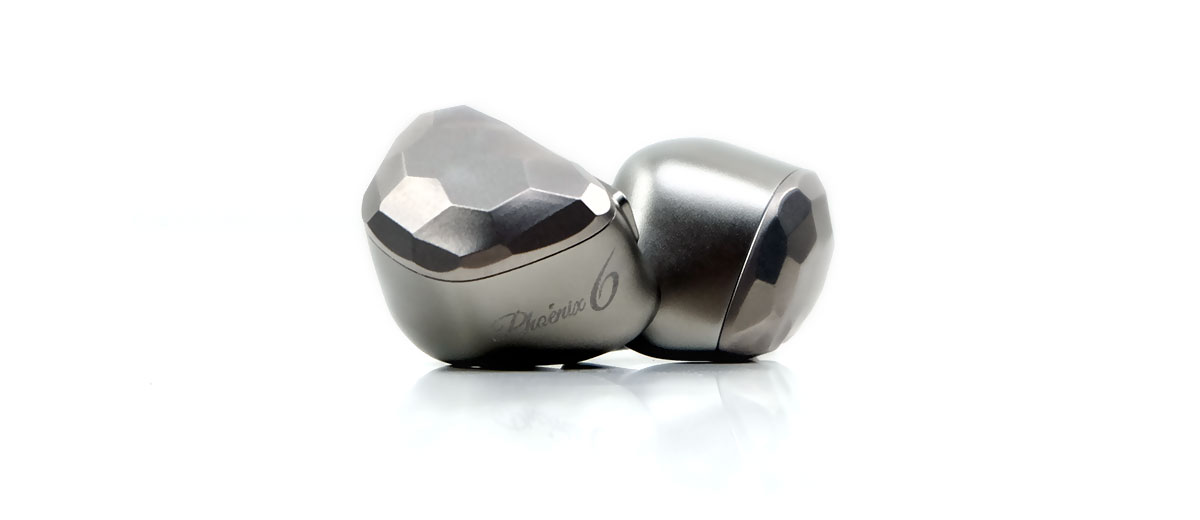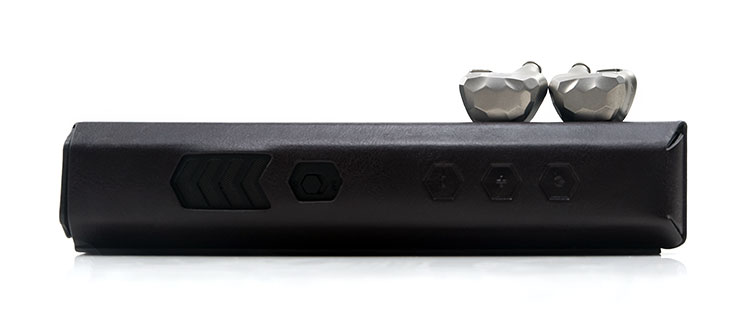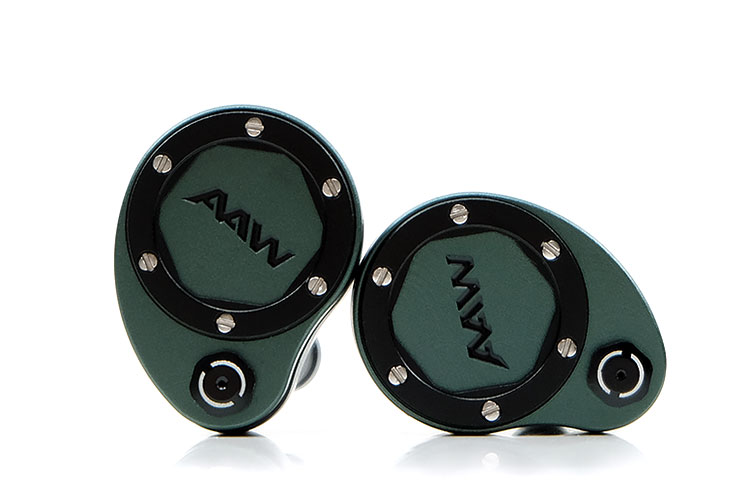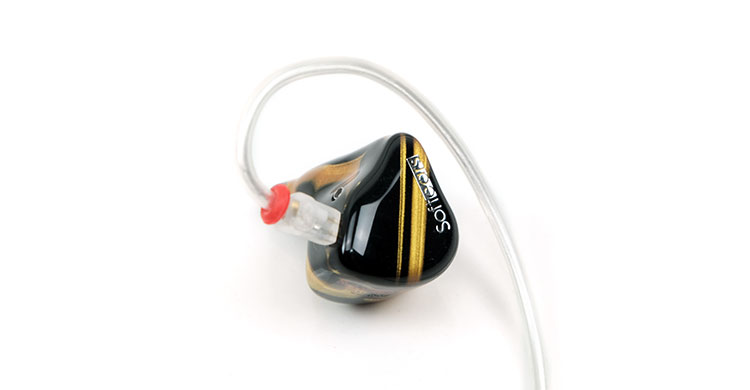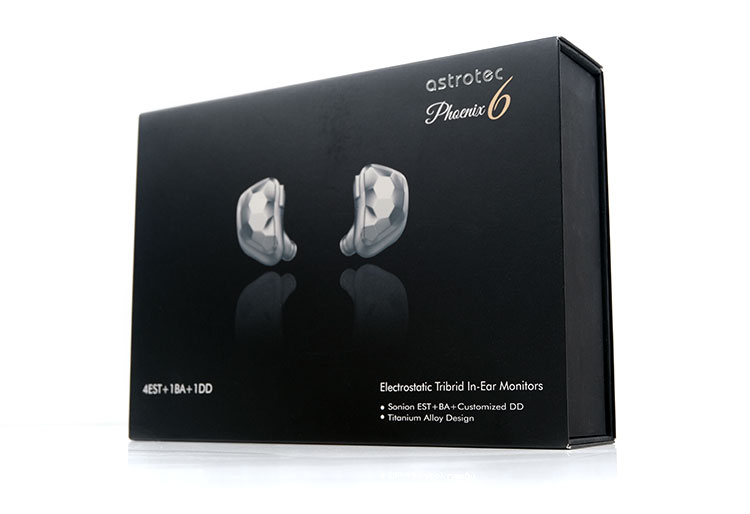Synergy
Efficiency
The Astrotec Phoenix 6 is rated at just 5Ω and 108dB SPL. For a quad electrostatic hybrid, it does reasonably well in terms of being easily driven. It is not the most sensitive IEM per se but compared to our selected comparison models which also use Sonion drivers it does volume match at a lower level.
I think more importantly is its dynamic range capability which seems optimal also at those lower levels with marginal volume increases having an effect. For example, the Softears Cerberus can sound close at the same level of volume but it takes a lot more dB to push its volume up progressively compared to the Phoenix 6.
DAPs and good quality dongles will have no issues driving the Phoenix 6, especially if you opt for the supplied premium cable which comes with a Pentaconn 4.4mm jack.
I couldn’t find any noise issues either with DAPs with known high noise floors quiet as a church mouse. If you are pairing a FiiO M15 or balanced out from the HiBy R8 then the background will be pleasingly black.
The Phoenix 6 does seem capable of scaling also with better power, particularly on the low-end which offers more dynamic range, air, and improved separation when going balanced from powerful DAPs such as the M17.
That is not to say you need to spend megabucks to get the best out of this IEM. Dongles such as the RU6 and the LPL W2 also offered a very dynamic and pleasing performance from their balanced outputs.
Pairings
Pairing the Phoenix 6 was done using 4 DAPs and 2 high-end dongles with my personal preferences switching a lot between neutral and smoother R2R sources depending on my mood. Both had pros and cons with some source material sounding more expansive and airier with better bass impact whilst others delivered a smoother vocal timbre.
HiBy
For example, the two HiBy DAPs tested, the R8 and the RS6 both had contrasting results. The RS6 offered the better timbre for me with its R2R NOS setting, especially on vocals which sounded very easy on the ear.
However, the R8 improved the staging and injected a lot more air and dynamic range. The Phoenix 6 bass performance offered better texture and layering and treble notes had more presence. However, the upper mids sounded a little more digital and thinner compared to the denser RS6 tuning.
Given the Phoenix 6 can struggle a little with midrange resolution I would probably go with the R8 over the RS6 for the improved dynamic range and resolution.
Cayin
If you want to stick with R2R (NOS), I might swing you more to the N6ii and the R01 motherboard pairing. Here the Phoenix 6 did have more treble reach, sparkle, and air compared to the RS6 pairing.
The bass also felt a little more defined and weightier sub-50Hz which suits the Phoenix 6’s elevated bass shelf. Mids are not as creamy as the RS6 but do benefit from a bit more space to breathe.
If you want to retain the creamier vocal performances I would suggest going with their RU6 dongle with the NOS option turned. It definitely turns on the bass tap a bit more and brings everything a bit closer delivering a rich full-bodied tone to the Phoenix 6 vocals.
FiiO
If you are planning to pair with the FiiO M17 this pairing was probably the best for dynamic range and bass impact. The Phoenix 6’s dynamic driver laps up the additional power and it does sound incredibly tight and responsive as a result. However, vocals are not quite as smooth with an increase in treble overtones for countertenor vocals.
Select Comparisons
AAW Halcyon
SG$1,999
Technical
The AAW Halcyon was launched around mid-2020 and represents excellent value with a configuration not too far off the Phoenix 6 either. This is also a tribrid universal IEM with 4 electrostatic drivers, 2 balanced armature drivers, and a single 10mm graphene diaphragm dynamic driver.
The configuration is fairly straight forward with the dynamic driver acting as the sub-woofer for the lows, the BA drivers for the mids, and the e-stats for the highs using a 4 Way Passive+Acoustic Crossover. The Phoenix 6 is very similar save for the fact the precise dynamic driver is unknown and it has but 1 BA for the mids instead of two.
Both monitors are using the 2nd gen energizer for their quad electrostatic driver pack for the highs so that means neither will be super inefficient and neither requires the same level of damping as the Gen 1 series.
That is reflected in both of their specs with the Halcyon reasonably sensitive at 24Ω and 104dB SPL though not quite as sensitive compared to the Phoenix 6 rated at 5Ω and 108dB SPL.
The one key difference from the Phoenix 6 is Halcyon’s BassFlow control system. This is a set of 3 filters on each driver’s faceplate that regulates the air supply to the dynamic driver (venting) to alter both the response and timbre of the low-end of the Halcyon by up to 10dB.
Design
Both the Halcyon and the Phoenix 6 are metal-based IEMs but the aesthetics and materials used are quite different.
The Halcyon has this military vibe with a mesh of consistent anodized green CNBC machined aluminum with a bolted circular black ring layered on top of the faceplate. The filters are also finished in matching black to match the screwed-down outer ring with the entire plate underpinned by a black metal shell.
The Phoenix 6 is more subtle with raw titanium or a silvery finish and those nuanced honeycomb stamps on the dome-like plate on the top. It’s more seamless, less two-tone than the Halcyon. The Phoenix 6 is also smaller and curvier than the Halcyon though the weight difference is quite marginal between the two.
Of the two, the Phoenix 6 is the more comfortable with that superior curving and smaller form factor. It has a flusher finish that allows it to tuck right into your ear whereas the more rigid-lined Halcyon can stick out a bit more depending on the tips you use.
Top-notch cables from both AAW and Astrotec with the Halcyon’s modded Thera cable shading it a little for me in terms of wire material. This is a 1.2m 24AWG UP-OCC Cryo-silver Litz Type 5 wire with a 10% silver solder finish and 24k gold-plated pin contacts.
That’s a bigger gauge than the 26AWG of the premium cable that comes with the Phoenix 6. Both have complementary aesthetics to the driver shells with the military CNC aluminum running right through the Halcyon cable and the titanium materials on the Phoenix 6 cable.
Performance
Very different approaches here despite having very similar configurations. The Phoenix 6 is smoother, weightier, and with stronger bass and vocal focus. Whereas the Halcyon is cleaner and punchier with an improved and airier top-end performance. Both have their strengths and both have some technical chops in different areas.
For a start, the Phoenix 6 has a much heavier sub-100Hz bass rumble. The Halcyon can punch quite well but you have to really push up to the Bass filter and add some final E tips to get close and even then I still consider it relatively polite in comparison.
Swings and roundabouts though because the additional BA in the mids from the Halcyon creates a more resolving midrange for me. Combined with a cleaner lighter timbre the Halcyon delivers the more complex and wider staging through those mids and highs.
The Phoenix 6 staging is more bass and vocal emphasized with instrumental imaging falling back and behind with less of a treble shimmer to give those nuanced imaging cues a bit of a lift.
The Halcyon vocal range has a slight dip in the 2-4k range creating a more neutral image for the female vocals from the Halcyon. The Phoenix 6 vocals are much further forward, denser sounding also, and comparatively warmer. Of the two, the Phoenix vocals are the more euphonic and the more forgiving.
The forgiving is from the Phoenix 6 treble tuning which is more relaxed from 5k onwards and with a downwards curve to 10k. The Halcyon has more energy from 5-8k and you can hear that with those clean overtones in the upper mids percussion and vocal timbre.
Empire Ears Valkyrie II
$1599
Technical
The Valkyrie II was launched in 2020 and builds on the original with some revised tuning and an upgraded Weapon IX dynamic driver. Like the Phoenix 6, this is also a tribrid but with only 1 electrostatic driver (Sonion Gen 2) as opposed to 4 that are inside the Astrotec design.
The rest of the configuration is similar with a single dynamic driver for the lows and a single BA for the mids. However, whereas the Astrotec does not openly go into their DD details, Empire Ears is all about that Weapon IX, this time a new Weapon IX+ 9mm woofer driver.
This is a proprietary rare-earth magnet-infused dynamic driver enclosed in a tuned bass-reflex system with front and rear-firing venting ports. It also has a fairly large voice coil for its dimensions making it one of the ‘phatest’ sounding dynamic drivers around. On top of that, EE has stuffed in their EIVEC tech for the electrostatic drivers and A.R.C coating internal to lower distortion.
Ratings wise both have really low impedance levels at 3Ω for the Valkyrie II and 5Ω for the Phoenix 6. However, in real-world testing, the Valkyrie does need a bit more juice at just 100dB SPL compared to 108dB for Astrotec’s configuration. That may well be down to the Weapon X DD more than their respective electrostatic arrays given the Valkyrie II only uses 1 driver as opposed to 4.
Design
This is classic hollow body acrylic with a brightly themed faceplate versus a denser solid titanium 3-piece shell. Both have contours, both fit beautifully in the ear. Though the Phoenix 6 is a shade heavier than the Valkyrie II, is actually quite a bit more compact despite housing a larger number of drivers.
The Phoenix 6 is very consistent with its machining whereas the Dragonhide plate of the Valkyrie II is going to catch many an eye. If anything, the shell of the EE design is the plain jane as they use it for all of their IEMs right up to the flagships.
The contouring on these IEMs keeps them both snug in my ear with the Phoenix shading it in terms of flusher fit. The supplied Final E tips do work better for me than the Phoenix 6 alternatives. I do wish the 6 came with Final E tips as once you swap them over from the Valkyrie II the seal is similar.
The Valkyrie II uses EE’s Alpha Hybrid IV cable which is a modded Effect Audio Eros II. This is a 4-wire 26AWG UPOCC Litz copper/UPOCC silver hybrid cable wrapped in a PVC translucent jacket so you can see that nice blend of silver and copper wire in its tight braided twist.
The Phoenix 6 is close to this spec using a 4-wire 26AWG OCC SPC tightly braided in a PVC outer jacket. They both handle well, with no kinks when unrolling and low noise levels during use.
The only physical difference is the finishing around the barrels with the Phoenix 6 using titanium for a more premium finish and that silver insulation to give it a shinier look. EE mods also have a similar copper accent but over aluminum rather than titanium.
Performance
The Valkyrie II wears its bass heart on its sleeve loud and proud whereas the Phoenix 6 does great bass but just holds back from being an all-out attack monster.
Neither of these two monitors is what I would call a resolution kings. They both aim to emphasize the popular touchpoints of modern music namely the bass and vocals and here both are more aggressive and forward sounding.
It’s the physicality of the sub-bass and the coloration of the upper mids that creates the differences. The Valkyrie II is more v-shaped with a stronger sub-bass elevation whereas the Phoenix 6 is raised from 20Hz to 100hz but more linear through the range and not so elevated sub-50Hz.
They can dig deep but the rumble from the Weapon IX+ driver is visceral and slightly tighter with less of a mid-bass bump and warmth coming through into the mids. The Phoenix 6 also has a clean drop at 100hz for separation but its FR slowly rises to 1k creating a bit more warmth and lower-mids presence.
Both are pushing on the 2-4k pinna gain but the Valkyrie II really pushes harder and it has to or else the bass would drown them out. Lower-mid instrumentals are well behind upper-mids vocals and percussion peaks but the male vocals do sound relatively clean and clear around 1k.
The Phoenix 6’s 2-4k range is more controlled but creates a relatively similar balance with its bass level. Vocals are smoother to my ear and not quite as thinned out also. The Phoenix 6 e-stat drivers are not as elevated around 8k as the Valkyrie II, so the tuning is more relaxed with less shimmer and percussion bite.
Softears Cerberus
$2099
Technical
The Cerberus has been out for a while now but our review was quite recent in February of this year. I believe this was their debut IEM at the high-end and like the Phoenix 6 this is also a tribrid configuration with a hybrid mix of dynamic, BA, and electrostatic.
The precise configuration is a single 10mm dynamic driver for the lows, 4 BA drivers for the mids and mid-highs, and a Sonion dual electrostatic driver pack for the highs.
This differs slightly from the Phoenix 6 which places more emphasis on the highs and ultra-highs with their gen 2 Sonion quad pack of e-stat drivers. I also believe the Cerberus uses the older Gen 1 energizer for its e-state driver assembly. Having said that the rated efficiency on paper is not too far off the Phoenix 6 with a matching 5Ω impedance and a slightly lower SPL of 104dB.
The other quirk of the Cerberus driver assembly is the inclusion of a single additional passive BA driver alongside the main quad BA pack. These do not emit sound but rather vibrate passively to attenuate air pressure, reduce fatigue, and improve the physicality and richness of the BA response. Think of it a bit like a unique interpretation of a bone conduction driver.
Design
Another acrylic creation (Cerberus) versus the titanium shell of the Phoenix 6. And again, the acrylic design is the bigger one though I have to say it is very attractively finished with its dark black base and liquid wood-style tans running through its entire body.
For me, the Phoenix 6’s cleverly chiseled titanium is more impressive the closer you get to it whereas the Cerberus stands out easily from afar. Both have some decent contouring but would you believe that the Phoenix 6 titanium shell has the stronger curves? That’s impressive to my tired old eyes.
Because of the enhanced curving and smaller body, the Phoenix 6 is a flusher fit in the ear taking up much less space compared to the Cerberus which sticks out a bit. The Cerberus does seal well though with that long nozzle design. Of the two, it seals a bit better though you can reduce the gap with better tips on the Phoenix 6.
No doubt the Phoenix 6 premium version is the better of the two stock cables. The blander second stock cable supplied by Astrotec is closer to the level of the Cerberus equivalent.
Softears has included a 4-core 0.78mm 2-pin terminated 6N silver-plated single-crystal copper cable which on the face of it should compete quite well with the Phoenix 6 cable. It is really the handling and more premium finishing and materials used that create a more premium impression of the Astrotec cable.
Performance
You can tell right away that the quad pack of e-state drives in the Pheonix 6 is performing to a higher level than the dual gen 1 Sonion versions inside the Cerberus. It’s cleaner, more forward, and energetic sounding.
Now given that both have an FR where the treble fades away progressively this is more down to efficiency for me and how much damping has been applied. It seems more so in the case of the Cerberus which lacks presence in the 7-8k region.
As a result, the Cerberus mids timbre is a bit more rounded sounding with less contrast compared to the spritely Pheonix 6 tuning. However, the additional BA configuration for the Cerberus mids does offer a bit more detail. Especially so in percussion texture that throws up a bit more character in the notes as a result.
The tuning curve from the Phoenix 6 is what most would describe as quite ‘musical’ with pushed upper mids and sub-to-mid-bass elevated bass shelf. It adds some nice weight to the lower-pitching instrumental harmonics alongside the stronger treble overtone.
The Cerberus is quite linear from 100hz up to almost 1k, with very few major dips and valleys. A slight 1-2k bump combined with some warmth gives male vocals some welcome presence whereas the Phoenix 6 is much more forward for female vocals.
The bass on the Phoenix 6 is heavier but also tighter and punchier. The Cerberus low-end is more indistinct despite its sub-bass lift. The rumble is good but it lacks a bit of punch around 100Hz which the Phoenix 6 can provide.
Our Verdict
The Astrotec Phoenix 6 is a surprise package for me. I wasn’t expecting such a mature, smooth, and agreeable sound signature. This is a tuning clearly aimed at the Western market with a thumping bass performance, smooth and inviting vocal tones, and a coherent but inoffensive treble.
If there is one weak spot it’s the resolution from the mids at the micro-level where I think pushing the boat out and throwing in another BA driver and splitting the frequency range coverage might have produced a more complete result. However, from a macro level, the Phoenix 6 is absolutely an enjoyable and fun listening experience.
Lest we not forget the physical attributes. I think only the Gaudio IEMs come close to wiring this level of contouring magic into a metal construction. The fact that Astrotec achieved it with titanium whilst keeping the Phoenix 6 design so compact is a credit to their design team. They look very attractive indeed.
So welcome to the bigger leagues Astrotec, the Phoenix 6 is a competitive performer, a bit of a looker, and provides a credible alternative to some universal hybrid alternatives.
Astrotec Phoenix 6 Specifications
- Impedance: 5 ohm
- Sensitivity: 108 dB/1mW
- Cable: High purity OCC 4.4mm + Silver plated cable 3.5mm
- Cable Length: 1.2m
- Connector: 2 Pin
- Frequency Response: 5Hz – 50000Hz
- Input:1 mW
- Max Input: 5mW

